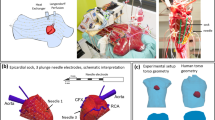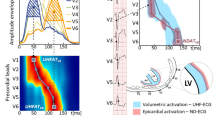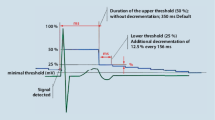Abstract
Reduction of sudden death requires accurate identification of patients at risk for ventricular tachycardia (VT) and effective therapies. The Multicenter Unsustained Tachycardia Trial and Multicenter Automatic Defibrillator Implantation Trials demonstrate that the implantable cardioverter defibrillator impacts favorably on the incidence of VT in patients with myocardial infarction, underscoring the need to detect the electrophysiologic abnormalities required for the development of VT. Methods used for this purpose include: Holter monitoring, ejection fraction, signal-averaged ECG, heart rate variability, T-wave alternans, baroreflex sensitivity, and programmed stimulation. Performance of each method alone has demonstrated high-negative but low-positive predictive values. Recent studies confirm that their use in combination augments performance.
A second approach for improving performance has been to reexamine how well each method detects the electrophysiological derangements that lead to VT. Our recent work has focused on the signal-averaged ECG. Judging from transmural maps of ventricular activation during VT and sinus rhythm obtained from patients, late potentials fail to detect completely signals from myocardium responsible for VT. To obviate this limitation we developed an approach based on inferred epicardial potentials in the frequency domain from 190-surface ECGs using individualized heart-torso models. Torso geometry and electrode positions are measured with a 3-armed digitizer. The location of cardiac structures is determined using echocardiography. The pericardial surface is approximated by a sphere that encloses the heart. Epicardial potentials are inferred using the boundary element method with zero-order Tikhonov regularization and the Composite Residual Smoothing Operator over the QRS complex. Studies are underway to determine if analysis of bioelectrical signals enveloping arrhythmogenic tissue improves identification of patients vulnerable to VT.
Similar content being viewed by others
References
Buxton AE, Lee KL, Fisher JD, Josephson ME, Prystowsky EN, Hafley GA. A randomized study of the prevention of sudden death in patients with coronary artery disease. N Engl J Med 1999341:1882–1890.
Moss AJ, Hall WJ, Cannom DS, Daubert JP, Higgins SL, Klein H, Levine JH, Saksena S, Waldo AL, Wilber D, Brown MW, Heo M for the Multicenter Automatic Defibrillator Implantation Trial Investigators. Improved survival with an implanted defibrillator in patients with coronary disease at high risk for ventricular arrhythmias. N Engl J Med 1996;335:1933–1940.
Moss AJ, Zareba W, Hall WJ, Klein H, Wilber D, Cannom DS, Daubert JP, Higgins SL, Brown MW, Andrews ML, for the Multicenter Automatic Defibrillator Implantation Trial Investigators. Prophylactic implantation of a defibrillator in patients with myocardial infarction and reduced ejection fraction. N Engl J Med 2002;346:877–883.
Ruberman W, Weinblatt E, Goldberg JD, Frank CW, Chaudhary BS, Shapiro S. Ventricular premature complexes and sudden death after myocardial infarction. Circulation 1981;64:297–305.
Anderson KP, DeCamilla J, Moss AJ. Clinical significance of ventricular tachycardia (3 beats or longer) detected during ambulatory monitoring after myocardial infarction. Circulation 1978;57:890–897.
Bigger JT, Weld FM, Rolnitzky LM. Prevalence, characteristics and significance of ventricular tachycardia (three or more complexes) detected with ambulatory electrocardiographic recording in the late hospital phase of acute myocardial infarction. Am J Cardiol 1981;48:815–823.
Bigger JT, Fleiss JL, Kleiger R, Miller JP, Rolnitzky LM the Multicenter Post-Infarction Research Group. The relationships among ventricular arrhythmias, left ventricular dysfunction and mortality in the 2 years after myocardial infarction. Circulation 1984;69:250–258.
Mukharji J, Rude RE, Poole WK, Gustafson N, Thomas LJ, Strauss HW, Jaffe AS, Muller JE, Roberts R, Raabe DS, Croft CH, Passamani E, Braunwald E, Willerson JT the MILIS Study Group. Risk factors for sudden death after acute myocardial infarction: Two-year follow-up. Am J Cardiol 1984;54:31–36.
Gomes JA, Mehra R, Barreca B, El-Sherif N, Harriman R, Holtzman R. Quantitative analysis of the high-frequency components of the signal-averaged QRS complex in patients with acute myocardial infarction: A prospective study. Circulation 1985;72:105–111.
Kuchar DL, Thorburn CW, Sammel NL. Late potentials detected after myocardial infarction: Natural history and prognostic significance. Circulation 1986;74:1280–1289.
Kleiger RE, Miller JP, Bigger JT, Moss AJ. The Multicenter Post-Infarction Research Group. Decreased heart rate variability and its association with increased mortality after acute myocardial infarction. Am J Cardiol 1987;59:256–262.
La Rovere M, Specchia G, Mortara A, Schwartz PJ. Barore-flex sensitivity, clinical correlates, and cardiovascular mortality among patients with a first myocardial infarction: A prospective study. Circulation 1988;78:816–824.
Rosenbaum DS, Jackson LE, Smith JM, Garan H, Ruskin JN, Cohen RJ. Electrical alternans and vulnerability to ventricular arrhythmias. N Engl J Med 1994;330:235–241.
Zareba W, Moss AJ, Cessie SI. Dispersion of ventricular repolarization and arrhythmic cardiac death in coronary artery disease. Am J Cardiol 1994;74:550–553.
Cain ME, Anderson JL, Arnsdorf MF, Mason JW, Scheinman MM, Waldo AL. American College of Cardiology Expert Consensus Document: Signal-averaged electrocardiography. J Am Coll Cardiol 1996;27:238–249.
El-Sherif N, Scherlag BJ, Lazzara R, Hope RR. Reentrant ventricular arrhythmias in the late myocardial infarction period. I. Conduction characteristics in the infarction zone. Circulation 1977;55:686–702.
Klein H, Karp RB, Kouchoukos NT, Zorn GL, James TN, Waldo AL. Intraoperative electrophysiologic mapping of the ventricles during sinus rhythm in patients with previous myocardial infarction. Circulation 1982;66:847–853.
Gardner PI, Ursell PC, Fenoglio JJ, Wit AL. Electrophysiologic and anatomic basis for fractionated electrograms recorded from healed myocardial infarcts. Circulation 1985;72:596–611.
Hanich RF, deLangen CDJ, Kadish AH, Michelson EL, Levine JH, Spear JF, Moore EN. Inducible sustained ventricular tachycardia 4 years after experimental canine myocardial infarction: Electrophysiologic and anatomic comparisons with early-healed infarcts. Circulation 1988;77:445–456.
Simson MB, Untereker WJ, Spielman SR, Horowitz LN, Marcus NH, Falcone RA, Harken AH, Josephson ME. Relation between late potentials on the body surface and directly recorded fragmented electrocardiograms in patients with ventricular tachycardia. Am J Cardiol 1983;51:105–112.
Schwarzmaier J, Karbenn U, Borggrefe M, Ostermeyer J, Breithardt G. Relation between ventricular late endocardial activity during intraoperative endocardial mapping and low-amplitude signals within the terminal QRS complex of the signal-averaged surface electrocardiogram. Am J Cardiol 1990;66:308–314.
Berbari EJ, Scherlag BJ, Hope RR, Lazzara R. Recording from the body surface of arrhythmogenic ventricular activity during the S-T segment. Am J Cardiol 1978;41:697–702.
Simson MB. Use of signals in the terminal QRS complex to identify patients with ventricular tachycardia after myocardial infarction. Circulation 1981;64:235–241.
Cain ME, Ambos HD, Witkowski FX, Sobel BE. Fast Fourier transform analysis of signal-averaged New Directions in Risk Stratification 117 electrocardiograms for identification of patients prone to sustained ventricular tachycardia. Circulation 1984;69:711–720.
Pierce DL, Easley AR, Windle JR, Engel TR. Fast-Fourier transformation of the entire low amplitude late QRS potential to predict ventricular tachycardia. J Am Coll Cardiol 198914:1731–1740.
Haberl R, Jilge G, Pulter R, Steinbeck G. Spectral mapping of the electrocardiogram with Fourier transform for identification of patients with sustained ventricular tachycardia and coronary artery disease. Eur Heart J 198910:316–322.
Lander P, Albert DE, Berbari EJ. Spectrotemporal analysis of ventricular late potentials. J Electrocardiol 1990;23:95–108.
Kelen GJ, Henkin R, Starr A, Caref EF, Bloomfield D, El-Sherif N. Spectral turbulence analysis of the signal-averaged electrocardiogram and its predictive accuracy for inducible sustained monomorphic ventricular tachycardia. Am J Cardiol 1991;67:965–975.
Schels HF, Haberl R, Jilge G, Steinbigler P, Steinbeck G. Frequency analysis of the electrocardiogram with maximal entropy method for identification of patients with sustained ventricular tachycardia. IEEE Trans Biomed Eng 1991;38:821–826.
Haberl R, Schels HF, Steinbigler P, Jilge G, Steinbeck G. Top-resolution frequency analysis of electrocardiogram with adaptive frequency determination: Identification of late potentials in patients with coronary artery disease. Circulation 1990;82:1183–1192.
Spear JF, Richards DA, Blake GJ, Simson MB, Moore EN. The effects of premature stimulation of the his bundle on epicardial activation and body surface late potentials in dogs susceptible to sustained ventricular tachyarrhythmias. Circulation 1985;72:214–224.
El-Sherif N, Gough WB, Restivo M, Craelius W, Henkin R, Caref EB. Electrophysiological basis of ventricular late potentials. PACE 1990;13:2140–2147.
Simson MB, Untereker WJ, Spielman SR, Horowitz LN, Marcus NH, Falcone RA, Harken AH, Josephson ME. Relation between late potentials on the body surface and directly recorded fragmented electrocardiograms in patients with ventricular tachycardia. Am J Cardiol 1983;51:105–112.
Schwarzmaier J, Karbenn U, Borggrefe M, Ostermeyer J, Breithardt G. Relation between ventricular late endocardial activity during intraoperative endocardial mapping and low-amplitude signals within the terminal QRS complex of the signal-averaged surface electrocardiogram. Am J Cardiol 1990;6:308–314.
DeBakker JMT, Coronel R, Tasseron S, Wilde AAM, Opthof T, Janse MJ, VanCapelle FJL, Becker AE, Jambroes G. Ventricular tachycardia in the infarcted, Langendorffperfused human heart: Role of the arrangement of surviving cardiac fibers. J Am Coll Cardiol 1990;15:1594–1607.
Wiener I, Mindich B, Pitchon R. Fragmented endocardial electrical activity in patients with ventricular tachycardia: A new guide to surgical therapy. Am Heart J 1984;86:86–90.
Breithardt G, Seipel L, Ostermyer J, Karbenn U, Abendroth RR, Borggrefe M, Yeh HL, Bricks W. Effects of antiarrhythmic surgery on late ventricular potentials recorded by precordial signal averaging in patients with ventricular tachycardia. Am Heart J 1982;104:996–1003.
Marcus NH, Falcone RA, Harken AH, Josephson ME, Simson MB. Body surface late potentials: Effects of endocardial resection in patients with ventricular tachycardia. Circulation 1984;70:632–637.
Denniss AR, Johnson DC, Richards DA, Ross DL, Uther JB. Effect of excision of ventricular myocardium on delayed potentials detected by the signal-averaged electrocardiogram in patients with ventricular tachycardia. Am J Cardiol 1987;59:591–595.
Cassidy DM, Vassallo JA, Buxton AE, Doherty JU, Marchlinski FE, Josephson ME. The value of catheter mapping during sinus rhythm to localize site of origin of ventricular tachycardia. Circulation 1984;69:1103–1110.
Kienzle MG, Miller J, Falcone RA, Harken A, Josephson ME. Intraoperative mapping during sinus rhythm: Relationship to site of origin of ventricular tachycardia. Circulation 1984;70:957–965.
Cassidy DM, Vassallo JA, Miller JM, Poll DS, Buxton AE, Marchlinski FE, Josephson ME. Endocardial catheter mapping in patients in sinus rhythm: Relationship to underlying heart disease and ventricular arrhythmias. Circulation 1986;73:645–652.
Cain ME, Gomes JA, Hafley GE, Lee KL, Gold MR. Performance of the signal-averaged ECG in identifying patients inducible into sustained ventricular tachycardia (Abstract). Circulation 1996;94(Suppl):676.
Cain ME, Gomes JA, Hafley GE, Lee KL, Buxton AE. Performance of the signal-averaged ECG and electrophysiologic testing in identifying patients vulnerable to arrhythmic death or cardiac arrest (Abstract). Cirsculation 1999;100(Suppl):1266.
Pogwizd SM, Hoyt RH, Saffitz JE, Corr PB, Cox JL, Cain ME. Reentrant and focal mechanisms underlying ventricular tachycardia in the human heart. Circulation 1992;86:1872–1887.
Chung MK, Pogwizd SM, Miller DP, Cain ME. Three-dimensional mapping of the initiation of nonsustained ventricular tachycardia in the human heart. Circulation 1997;95:2517–2527.
Pogwizd SM, Chung MA, Cain ME. Termination of ventricular tachycardia in the human heart: Insights from three-dimensional of nonsustained and sustained ventricular tachycardia. Circulation 1997;95:2528–2540.
Hood MA, Pogwizd SM, Peirick J, Cain ME. Contribution of myocardium responsible for ventricular tachycardia to abnormalities detected by analysis of signal-averaged ECGs. Circulation 1992;86:1888–1901.
Nikolic G, Bishop RL, Singh JB. Sudden death recorded during Holter monitoring. Circulation 1982;66:218–225.
Pratt CM, Francis MJ, Luck JC, Wyndham CR, Miller RR, Quinones MA. Analysis of ambulatory electrocardiograms in 15 patients during spontaneous ventricular fibrillation with special reference to preceding arrhythmic event. JAm Coll Cardiol 1983;2:788–797.
Poqwizd SM, Corr PB. Mechanisms underlying the development of ventricular fibrillation during early myocardial ischemia. Citc Res 1990;66:672–695.
Cain ME, Ambos HD, Markham J, Lindsay BD, Arthur RM. Diagnostic implications of spectral and temporal analysis of the entire cardiac cycle in patients with ventricular tachycardia. Circulation 1991;83:1637–1648.
Arthur RM, Kavesh NG, Ambos HD, Cain ME. Spectral analysis of the cardiac cycle of signal-averaged Frank leads 118 Cain, Arthur, and Trobaugh from patients with ventricular tachycardia. J Electrocardiol 1995;27(Suppl):I218–I227.
Kavesh NG, Cain ME, Ambos HD, Arthur RM. Enhanced detection of distinguishing features in signal-averaged electrocardiograms from patients with ventricular tachycardia by combined spatial and spectral analysis of the entire cardiac cycle. Circulation 1994;90:254–263.
Arthur RM, Kavesh NG, Ambos HD, Cain ME. Phase and group-delay characteristics of signal-averaged electrocardiograms from patients with ventricular tachycardia. IEEE Trans Biomed Eng 1995;42:29–41.
Lindsay BD, Ambos HD, Schechtman KB, Arthur RM, Cain ME. Noninvasive detection of patients with ischemic and nonischemic heart disease prone to ventricular fibrillation. J Am Coll Cardiol 1990;16:1656–1664.
Lindsay BD, Markham J, Schechtman KB, Ambos HD, Cain ME. Identification of patients with sustained ventricular tachycardia by frequency analysis of signal-averaged electrocardiograms despite the presence of bundle branch block. Circulation 1988;77:122–130.
Arthur RM, Ambos HD, Cain ME. Construction of body surface isoharmonic maps from Frank XYZ leads. In:Computers in Cardiology. Washington, DC: IEEE Computer Society, 1991:471–474.
Beetner DG. Inference of spectral and temporal characteristics of pericardial potentials using individualized human heart-torso models and the multipole equivalent method. PhD thesis, Washington University, 1997.
Pilkington TC, Morrow MN. The utilization of spherical approximations to relate epicardial potentials to torso potentials. IEEE 1980 Frontiers of Engineering in Health Care 1980;9–12.
Perez JE, Miller JG, Barzilai B, Wickline S, Mohr GA, Wear K, Vered Z, Sobel BE. Progress in quantitative ultrasonic characterization of myocardium: From the laboratory to the bedside. J Am Soc Echocard 1988;1:294–305.
Feinberg MS, Gussak HM, Davila-Roman VG, Baumann CM, Miller JG, Perez JE. Dissociation between wall thickening of normal myocardium and cyclic variation of backscatter during inotropic stimulation. Am J Cardiol 1996;77:515–520.
Perez JE, Waggoner AD, Davila-Roman VA, Cardona H, Miller JG. On-line quantification of ventricular function during dobutamine stress echocardiography. Eur Heart J 1992;13:1669–1676.
Gulrajani RM, Savard P, Roberge FA. The Inverse Problem in Electrocardiography: Solution in Terms of Equivalent Sources. CRC Critical Reviews in Biomedical Engineering 1988;16:171–214.
Holt JH Jr, Barnard ACL, Lynn MS, Svendsen P. A study of the human heart as a multiple dipole electrical source I. Normal adult male subjects. Circulation 1969;40:687–696.
Arthur RM, Geselowitz DB, Briller SA, Trist RF, Qyadrupole components of the human surface electrocardiogram. Am Heart J 1972;83:663–677.
Rudy Y, Messinger-Rapport B. Inverse Problem in Electrocardiography: Solutions in terms of epicardial potentials. CRC Critical Reviews in Biomedical Engineering 1988;16:215–268.
Gulrajani RM, Roberge FA, Mailloux GE. The forward problem of electrocardiography. In: MacFarlane PW, Lawrie TDV, eds. Comprehensive Electrocardiography. Pergamon Press, 1989:197–235.
Ramsey M, Barr RC, Spach MS. Comparison of measured torso potentials with those simulated from epicardial potentials for ventricular depolarization and repolarization in the intact dog. Circ Res 1977;41:660.
Colli-Franzone P, Guerri L, Taccardi B, Viganotti C. Finite element approximation of regularized solution of the inverse potential problem of electrocardiography and applications to experimental data. Calcolo 1985;22:91.
Messinger-Rapport BJ, Rudy Y. Noninvasive recovery of epicardial potentials in a realistic heart-torso geometry. Circ Res 1990;66:1023–1039.
Throne RD, Olson LG, Hrabik TJ, Windle JR. Generalized eigen-system techniques for the inverse problem of electrocardiography applied to a realistic heart-torso geometry. IEEE Trans Biomed Eng 1997;44:447–454.
Barr RC, Spach MS. Inverse calculation of QRS-T epicardial potentials from body surface potential distributions for normal and ectopic beats in the intact dog. Circ Res 1978;42:661–675.
Budgett DM, Monro CM, Edwards SW, Stanbridge RK. Comparison of measured and computed epicardial potentials from a patient-specific inverse model. J Electrocardiol 1993;26(Suppl):165–173.
Shahidi AV, Savard P, Nadeau R. Forward and inverse problems of electrocardiography: Modeling and recovery of epicardial potentials in humans. IEEE Trans Biomed Eng. 1994;41:249–256.
Barr RC, Ramsey M, Spach MS. Relating epicardial to body surface potential distributions by means of transfer coefficients based on geometry measurement. IEEE Trans on Biomed Eng 1977;BME-24:1–11.
Arthur RM, Geselowitz D, Briller S, Trost R. Quadrupole components of the human surface electrocardiogram. Am Heart J 1972;83:663–677.
Tikhonov AN. Regularization of incorrectly posed problems. Soviet Mathematics 1963;4:1624–1627.
Messinger-Rapport BJ, Rudy Y. Regularization of the inverse problem in electrocardiology: A model study. Mathematical Biosciences 1988;89:79–118.
Colli-Franzone P, Guerri L, Tentoni S, Tentoni C, Viganotti C, Baruffi S, Spaggiari S, Taccardi B. A mathematical procedure for solving the inverse potential problem of electrocardiography. Analysis of the time-space accuracy from in vitro experimental data. Mathematical Biosciences 1985;77:353–396.
Cain ME, Ambos HD, Lindsay BD, Arthur RM. Contributions of frequency analysis to the identification of the spectral, temporal, and spatial features in signal-averaged electrocardiograms that distinguish patients prone to sustained ventricular arrhythmias. Prog Cardiovasc Dis 1992;35:189–212.
Author information
Authors and Affiliations
Corresponding author
Rights and permissions
About this article
Cite this article
Cain, M.E., Arthur, R.M. & Trobaugh, J.W. Detection of the Fingerprint of the Electrophysiological Abnormalities that Increase Vulnerability to Life-Threatening Ventricular Arrhythmias. J Interv Card Electrophysiol 9, 103–118 (2003). https://doi.org/10.1023/A:1026259702892
Issue Date:
DOI: https://doi.org/10.1023/A:1026259702892




